-
 Bitcoin
Bitcoin $107,323.9971
-0.42% -
 Ethereum
Ethereum $2,442.7415
-1.58% -
 Tether USDt
Tether USDt $1.0005
0.00% -
 XRP
XRP $2.0902
-4.49% -
 BNB
BNB $645.3561
-0.33% -
 Solana
Solana $140.8832
-2.81% -
 USDC
USDC $0.9999
0.01% -
 TRON
TRON $0.2713
0.17% -
 Dogecoin
Dogecoin $0.1611
-2.35% -
 Cardano
Cardano $0.5556
-2.75% -
 Hyperliquid
Hyperliquid $36.8045
-1.10% -
 Bitcoin Cash
Bitcoin Cash $494.4393
-1.23% -
 Sui
Sui $2.6406
-2.97% -
 Chainlink
Chainlink $13.0846
-1.74% -
 UNUS SED LEO
UNUS SED LEO $9.0127
0.09% -
 Avalanche
Avalanche $17.4023
-1.37% -
 Stellar
Stellar $0.2339
-3.25% -
 Toncoin
Toncoin $2.8330
-0.57% -
 Shiba Inu
Shiba Inu $0.0...01124
-3.38% -
 Litecoin
Litecoin $84.9229
-0.60% -
 Hedera
Hedera $0.1432
-3.84% -
 Monero
Monero $311.0740
-1.35% -
 Bitget Token
Bitget Token $4.6591
3.94% -
 Dai
Dai $1.0001
0.01% -
 Ethena USDe
Ethena USDe $1.0000
-0.01% -
 Polkadot
Polkadot $3.3033
-1.64% -
 Uniswap
Uniswap $6.9221
-4.55% -
 Pi
Pi $0.5546
-4.86% -
 Aave
Aave $257.5046
-1.30% -
 Pepe
Pepe $0.0...09215
-3.26%
Is it reliable if the platform is broken but the short volume is exhausted and it will rebound?
Short volume exhaustion may signal a potential rebound, but confirmation through open interest, liquidation data, and market structure is crucial before entering trades.
Jun 27, 2025 at 10:49 am
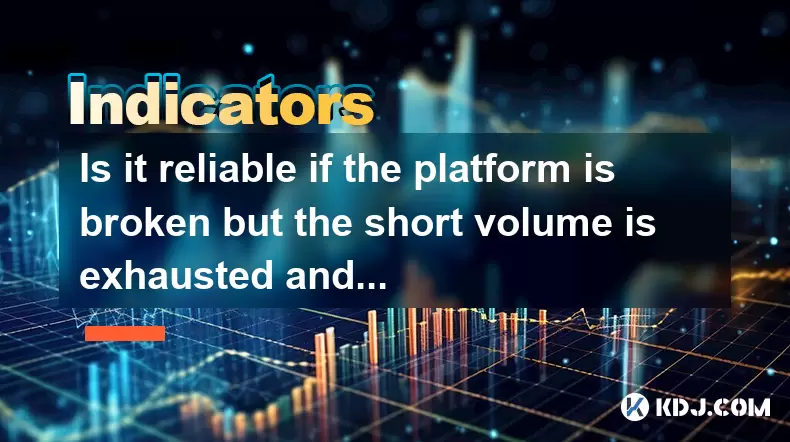
Understanding Market Dynamics: Platform Breakdown and Volume Exhaustion
In the cryptocurrency market, price movements are often influenced by technical indicators and trader sentiment. When a platform or price level breaks down but the short volume is exhausted, it raises questions about the reliability of a potential rebound. To assess this scenario accurately, traders need to understand how volume exhaustion affects bearish momentum and whether a reversal is likely.
Volume exhaustion typically occurs when a large number of traders have already taken short positions, and there are not enough new sellers to continue pushing the price lower.
This phenomenon can be observed through tools like open interest, funding rates, and on-chain data such as liquidation heatmaps. When these metrics indicate that most shorts have been executed or liquidated, the downward pressure may ease.
How to Identify Short Volume Exhaustion
To determine if short volume has truly been exhausted, several key indicators should be analyzed:
- Open Interest (OI): A drop in open interest during a price decline suggests that shorts are being closed out or liquidated.
- Funding Rates: In perpetual futures markets, negative funding rates indicate more shorts than longs. If funding rates stabilize or turn positive after a downtrend, it could signal short covering.
- Liquidation Heatmaps: These show where large liquidations occurred. A spike in short liquidations at a certain price level indicates strong support forming there.
- Order Book Depth: Sudden thinning of sell orders after a breakdown may imply that selling pressure has subsided.
By cross-referencing these signals, traders can better judge whether a rebound is credible or merely a dead cat bounce.
Analyzing Historical Reversals After Short Exhaustion
Historically, many major cryptocurrencies have experienced sharp rebounds after significant short liquidations. For instance, Bitcoin’s price action in early 2023 saw multiple instances where a breakdown was followed by a strong rally once short positions were largely liquidated.
In such cases, market structure patterns like bullish engulfing candles, hammer formations, and higher lows on the order book suggest a shift in control from bears to bulls.
Traders who monitor these patterns closely can position themselves for a potential rebound by:
- Setting up long entries near previously broken support levels that now act as resistance-turned-support.
- Using tight stop losses just below the recent low to manage risk.
- Watching for a breakout above the nearest resistance zone to confirm the trend change.
These strategies rely heavily on confirming that the short squeeze is underway before entering a trade.
Tools and Platforms to Monitor Short Activity
Several platforms offer real-time insights into short activity and volume dynamics. Traders can use:
- Bybt.com: This site provides liquidation data, funding rate comparisons, and sentiment analysis across major exchanges.
- Glassnode: Offers on-chain analytics including miner behavior, exchange flows, and supply distribution — all useful for gauging broader market health.
- TradingView: Allows users to overlay volume profiles, order book depth, and custom scripts to analyze market structure.
- Dune Analytics: Provides customizable dashboards built by the community that can track complex derivatives data and macro trends.
Using these tools together gives a more comprehensive view of whether the market is set for a reversal.
Risks and Limitations of Relying on Short Exhaustion Signals
While short volume exhaustion may hint at an upcoming rebound, it is not a guaranteed indicator. Markets can remain irrational longer than expected, and new waves of selling can emerge even after apparent exhaustion.
Some risks include:
- False breakouts: The price may briefly rebound only to fall again if institutional players continue dumping.
- News-driven volatility: Unexpected regulatory actions or macroeconomic events can override technical signals.
- Whale manipulation: Large holders can trigger fake liquidations to trap retail traders before resuming the downtrend.
Therefore, while short exhaustion is a useful tool, it should never be used in isolation.
Frequently Asked Questions
Q: What is considered a reliable sign of short exhaustion?
A reliable sign includes a combination of declining open interest, increased short liquidations, and stabilizing funding rates. Additionally, a visible reduction in selling pressure on the order book confirms that the market is losing its bearish momentum.
Q: Can a broken platform still act as support after a rebound?
Yes, especially if the breakdown occurred on high volume and was quickly followed by a surge in buying. In such cases, the broken platform can become a psychological level where traders expect buyers to step in again.
Q: How long does a rebound typically last after short exhaustion?
The duration varies depending on market conditions. Some rebounds last only a few hours (especially in highly volatile altcoins), while others can persist for days if accompanied by positive news or improved macro conditions.
Q: Should I enter a trade immediately after noticing short exhaustion?
It's generally safer to wait for confirmation, such as a candlestick reversal pattern or a breakout above a key resistance level. Entering too early without confirmation increases the risk of getting caught in a false move.
Disclaimer:info@kdj.com
The information provided is not trading advice. kdj.com does not assume any responsibility for any investments made based on the information provided in this article. Cryptocurrencies are highly volatile and it is highly recommended that you invest with caution after thorough research!
If you believe that the content used on this website infringes your copyright, please contact us immediately (info@kdj.com) and we will delete it promptly.
- Nintendo's Rare Sale: A Treat for Switch Gamers!
- 2025-06-27 18:30:12
- Crypto, Stablecoins, and the European Commission: Navigating the Regulatory Landscape
- 2025-06-27 19:27:14
- Neo Pepe Coin's Presale Heats Up Amidst Market Shifts: The Next Big Meme Coin?
- 2025-06-27 19:10:12
- Crypto Fundraising H1 Peak: Successful Closings Signal a Bullish Turn
- 2025-06-27 20:10:12
- Cathie Wood, Coinbase, and ATH: What's Driving the Crypto Buzz?
- 2025-06-27 20:10:12
- Cambridge Investment, Coinbase, and Stock Holdings: What's the Deal?
- 2025-06-27 18:30:12
Related knowledge
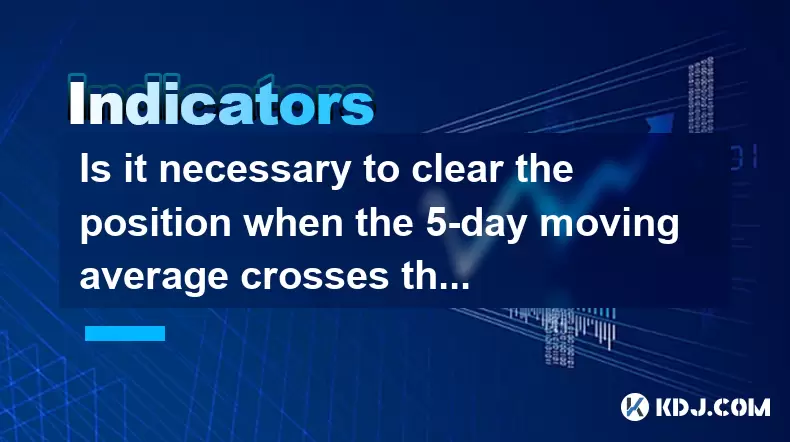
Is it necessary to clear the position when the 5-day moving average crosses the 10-day moving average?
Jun 27,2025 at 07:21pm
Understanding the 5-Day and 10-Day Moving AveragesIn the realm of technical analysis within the cryptocurrency market, moving averages play a crucial role in identifying trends and potential reversal points. The 5-day moving average (MA) and 10-day moving average are two of the most commonly used short-term indicators by traders. These tools smooth out ...
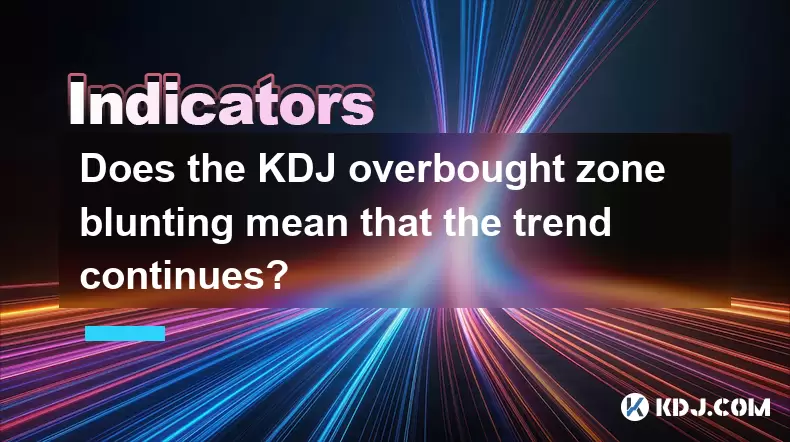
Does the KDJ overbought zone blunting mean that the trend continues?
Jun 27,2025 at 03:35pm
Understanding the KDJ Indicator in Cryptocurrency TradingThe KDJ indicator, also known as the stochastic oscillator, is a popular technical analysis tool used by traders to identify overbought or oversold conditions in asset prices. In the cryptocurrency market, where volatility is high and trends can change rapidly, understanding how to interpret the K...
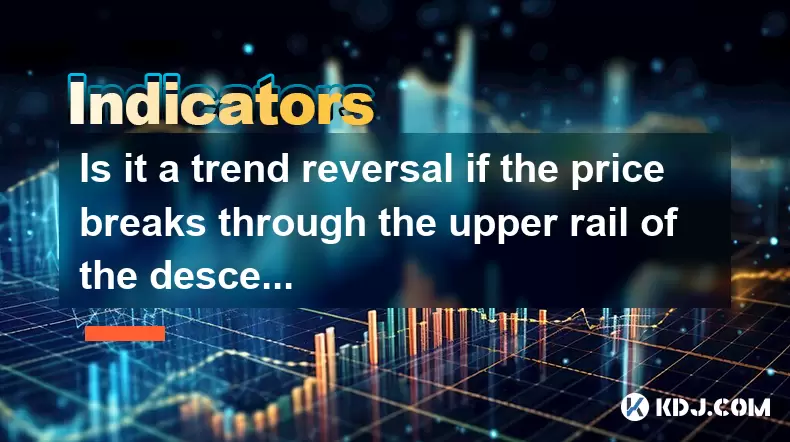
Is it a trend reversal if the price breaks through the upper rail of the descending channel and then steps back without breaking?
Jun 27,2025 at 05:35pm
Understanding the Descending Channel PatternA descending channel is a technical analysis pattern formed by two parallel downward-sloping trendlines, one acting as resistance and the other as support. This pattern typically indicates a continuation of a downtrend, where price action oscillates between these two boundaries. Traders often look for breakout...
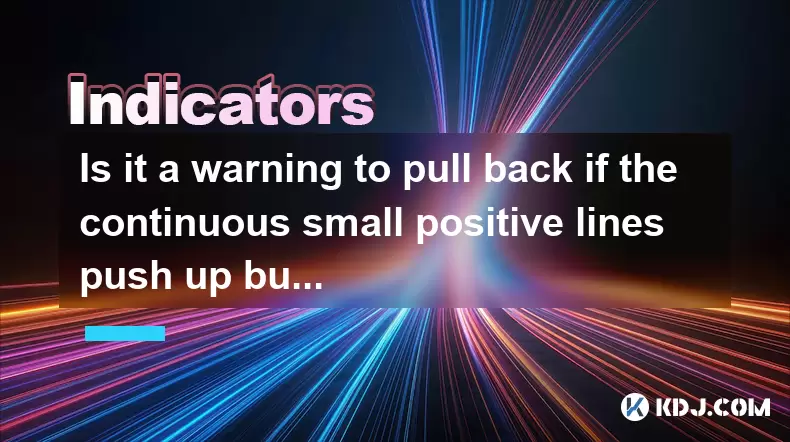
Is it a warning to pull back if the continuous small positive lines push up but the volume is insufficient?
Jun 27,2025 at 05:28pm
Understanding the Pattern: Continuous Small Positive LinesIn technical analysis, continuous small positive lines refer to a series of candlesticks where each candle closes slightly higher than its open. These candles usually have short wicks and indicate a gradual upward movement in price. Traders often interpret this pattern as a sign of steady buying ...
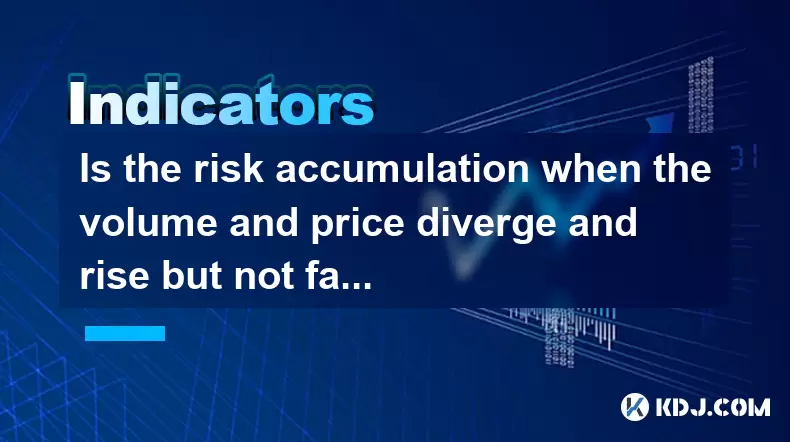
Is the risk accumulation when the volume and price diverge and rise but not fall?
Jun 27,2025 at 04:28pm
Understanding Volume and Price Divergence in Cryptocurrency TradingIn cryptocurrency trading, the relationship between volume and price plays a critical role in identifying market sentiment. When volume increases while price rises, it typically signals strong buying pressure and healthy market participation. However, when this correlation breaks—especia...
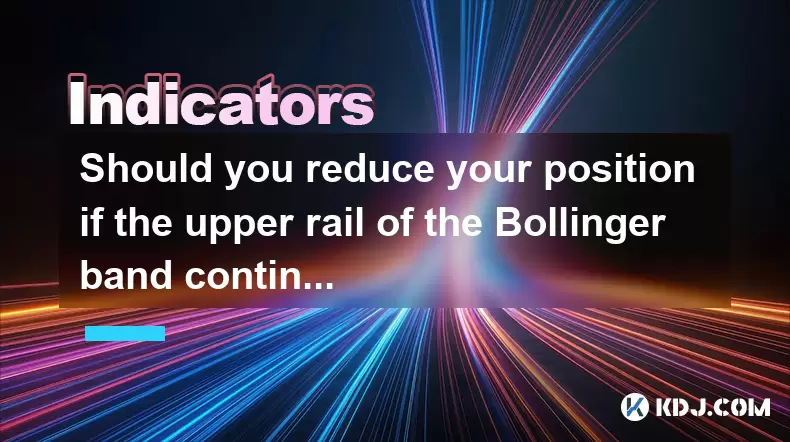
Should you reduce your position if the upper rail of the Bollinger band continues to be under pressure?
Jun 27,2025 at 06:22pm
Understanding the Bollinger Band and Its Upper RailThe Bollinger Band is a widely used technical indicator in cryptocurrency trading. It consists of three lines: a simple moving average (SMA) in the center, with two outer bands representing standard deviations above and below the SMA. The upper rail specifically reflects overbought conditions when price...

Is it necessary to clear the position when the 5-day moving average crosses the 10-day moving average?
Jun 27,2025 at 07:21pm
Understanding the 5-Day and 10-Day Moving AveragesIn the realm of technical analysis within the cryptocurrency market, moving averages play a crucial role in identifying trends and potential reversal points. The 5-day moving average (MA) and 10-day moving average are two of the most commonly used short-term indicators by traders. These tools smooth out ...

Does the KDJ overbought zone blunting mean that the trend continues?
Jun 27,2025 at 03:35pm
Understanding the KDJ Indicator in Cryptocurrency TradingThe KDJ indicator, also known as the stochastic oscillator, is a popular technical analysis tool used by traders to identify overbought or oversold conditions in asset prices. In the cryptocurrency market, where volatility is high and trends can change rapidly, understanding how to interpret the K...

Is it a trend reversal if the price breaks through the upper rail of the descending channel and then steps back without breaking?
Jun 27,2025 at 05:35pm
Understanding the Descending Channel PatternA descending channel is a technical analysis pattern formed by two parallel downward-sloping trendlines, one acting as resistance and the other as support. This pattern typically indicates a continuation of a downtrend, where price action oscillates between these two boundaries. Traders often look for breakout...

Is it a warning to pull back if the continuous small positive lines push up but the volume is insufficient?
Jun 27,2025 at 05:28pm
Understanding the Pattern: Continuous Small Positive LinesIn technical analysis, continuous small positive lines refer to a series of candlesticks where each candle closes slightly higher than its open. These candles usually have short wicks and indicate a gradual upward movement in price. Traders often interpret this pattern as a sign of steady buying ...

Is the risk accumulation when the volume and price diverge and rise but not fall?
Jun 27,2025 at 04:28pm
Understanding Volume and Price Divergence in Cryptocurrency TradingIn cryptocurrency trading, the relationship between volume and price plays a critical role in identifying market sentiment. When volume increases while price rises, it typically signals strong buying pressure and healthy market participation. However, when this correlation breaks—especia...

Should you reduce your position if the upper rail of the Bollinger band continues to be under pressure?
Jun 27,2025 at 06:22pm
Understanding the Bollinger Band and Its Upper RailThe Bollinger Band is a widely used technical indicator in cryptocurrency trading. It consists of three lines: a simple moving average (SMA) in the center, with two outer bands representing standard deviations above and below the SMA. The upper rail specifically reflects overbought conditions when price...
See all articles























































































